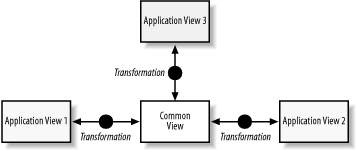15.1 Oracle Application Server InterConnect
| You can use OracleAS InterConnect to integrate applications from Oracle, other software providers, or custom-built applications using message-oriented middleware. OracleAS InterConnect enables integration through modeling rather than relying on extensive programming techniques. Integration logic is separate from the integration platform. OracleAS InterConnect components include a hub, adapters, and a Development Kit. Figure 15-1 shows a typical deployment configuration. Figure 15-1. Typical OracleAS InterConnect deployment The OracleAS InterConnect design and modeling tool, called i Studio, features easy-to-use wizards. Intended for use by business analysts, i Studio largely eliminates the need to write code when creating business rules and transformation integration logic. Users of i Studio can define and map data to be exchanged between applications, and can configure and deploy the integration. Objects can be locked within the tool, thus enabling multiple users to model and design simultaneously . OracleAS InterConnect supports metadata versioning so that multiple versions of the same object can coexist or be active at the same time. If business process collaboration is desired, Oracle Workflow can define the business processes. The i Studio tool is then used to associate semantic maps with these business processes. Components connected with OracleAS InterConnect and created in i Studio are called application views . Application views include interest in specific messages, internal datatype identification, and information on how a message should be mapped to or from an internal datatype. A common view is a hub view in which each spoke is an application view participating in the integration. Figure 15-2 shows the hub-and-spoke nature of OracleAS InterConnect deployment between the common view and application views. Figure 15-2. Typical OracleAS InterConnect hub and spoke Common views can contain the following components:
Transformations, sometimes call mappings , are the integration points to application views. Generated models and designs are stored in the OracleAS InterConnect metadata repository, which is part of a hub. At runtime, the metadata repository is the source of instructions enabling message exchange to occur. Runtime management, which is handled through Oracle Enterprise Manager, includes such management tasks as:
15.1.1 OracleAS InterConnect Adapters and MessagesOracleAS InterConnect Adapters provide connectivity via a bridge, the protocol/application-specific portion of the adapter. The adapters transform and route messages between an application and the hub. Data is transformed from application views to common views and from common views to application views, as defined in the metadata repository. Figure 15-3 shows the architecture of an adapter. Figure 15-3. OracleAS InterConnect Adapter architecture A number of prepackaged OracleAS InterConnect adapters are available, including:
Messages are commonly communicated using database adapters, Oracle AQ, or XML messaging, or through the Data Definition Description Language (D3L). All OracleAS InterConnect messages are guaranteed to be delivered exactly once in the order sent. Messages can be load-balanced across multiple adapters using Real Application Clusters (RAC), a clustered Oracle database configuration. Routing of messages can be implemented using business rules based on message content.
OracleAS InterConnect supports two distinct models:
Both publish and subscribe and request/reply messaging can behave in a point-to-point manner if the sending application calls out which specific application should receive a message. Values in one application can be mapped to equivalent values in another application by defining domain value maps using i Studio. Keys for corresponding entities in two different applications can also be correlated using i Studio. 15.1.2 i Studio InterfaceThe interface in the i Studio modeling and design tool consists of two navigation trees for design and deployment, as well as five main menus . Here are the navigation trees:
The menus include:
Figure 15-4 shows a typical view of the i Studio interface and the Design Navigation Tree. Figure 15-4. Typical iStudio interface 15.1.3 Oracle Workflow for JavaThe Oracle Workflow for Java (OW4J) engine can be used with OracleAS InterConnect to enable business process definition, automation, and integration. Oracle Workflow for Java enables execution of a sequence of events in a specific order. You can view the progress of processes through these sequences via either monitors or notification methods (for example, JMS messages and email). The following components are part of OW4J:
Business process models are typically created using the JDeveloper OW4J Modeler as the Workflow Builder . Business processes might be either short or long. Very short business processes are served by in-memory workflows. Long-lived tasks may extend to weeks and beyond. Version numbers are automatically assigned to workflow tasks, thus enabling different versions of activities. Models of these processes can be built to include logic for looping, branching into parallel flows and rendezvous, decomposing into subflows, branching into subtasks , and others. Escalation processes can be created and then executed after periods of inactivity based on predefined rules. Notification routing can also be set up to handle typical occurrences such as delegation of responsibility or rerouting during absence of a participant. The Process Monitor provides a Java applet to review business activities that have been completed, are active, or are yet to be initiated. Decision makers are identified and their responses are shown. Administrators can intervene to explore stopped processes or to skip or retry processes. It is possible to review the time and cost of business processes by exploring workflow processing data stored in an audit database. The Workflow Manager interface is exposed through Oracle Enterprise Manager. Work items and event messages can be viewed (including the distribution of event messages by status). This interface enables administrators to more quickly determine business bottlenecks. 15.1.4 Typical OracleAS InterConnect Deployment SequenceA typical OracleAS InterConnect deployment sequence includes the following steps:
|
EAN: 2147483647
Pages: 120
